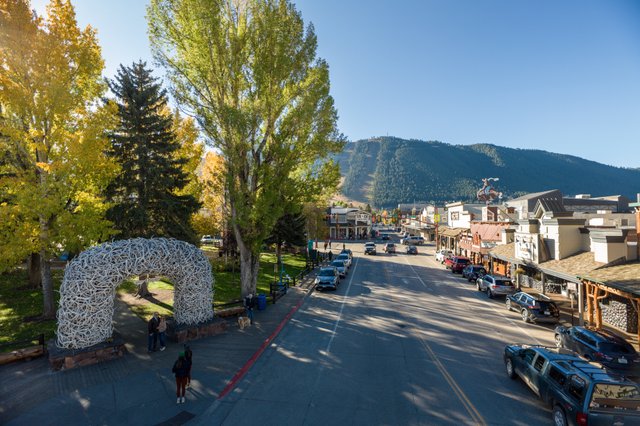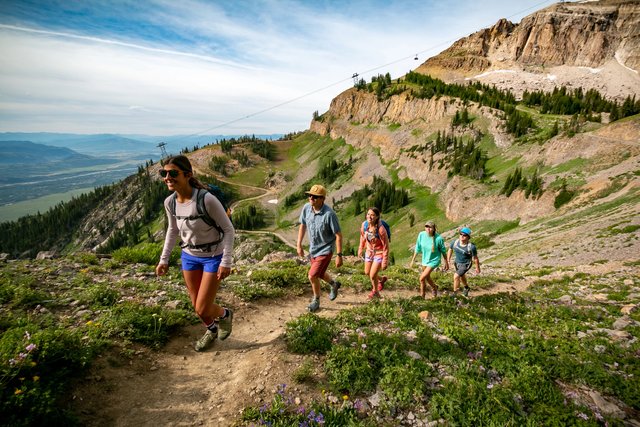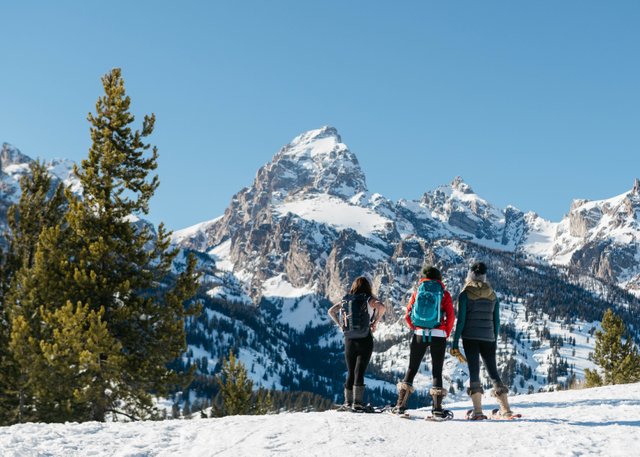Experiencing Jackson Hole Through the Seasons: A Guide to Weather and Dressing Appropriately

Jackson Hole is a beautiful place to visit in any season – spring is full of wildflowers and hungry bears emerging from hibernation, summer is perfect for swimming in the many lakes of Grand Teton National Park, fall is known for the aspens that turn a gorgeous shade of yellow, and winter is a snowsports lover’s paradise. When planning your visit, understanding the weather patterns and knowing how to dress for each season will ensure you stay comfortable and enjoy all that Jackson Hole has to offer. Here's a comprehensive guide to the seasonal weather in Jackson Hole and tips on how to dress for each season.
Spring (March to May)
Weather: Spring in Jackson Hole is a transitional season, characterized by gradually warming temperatures and melting snow. March can still feel quite wintery, with average highs around 40°F (4°C) and lows dipping to 18°F (-8°C). By May, temperatures rise to an average high of 60°F (16°C) and lows around 30°F (-1°C). Springtime can also bring unpredictable weather, with occasional snowstorms and rain showers. Some of our guides remember the year when the valley got three inches of snow on the Summer Solstice!
What to Wear:
Layering is Key: Start with a moisture-wicking base layer, add a warm mid-layer like a fleece or down jacket, and top it off with a waterproof and windproof outer layer.
Footwear: Waterproof boots are essential, especially for navigating muddy trails and melting snow.
Accessories: Don’t forget a hat and gloves for the cooler mornings and evenings.
Summer (June to August)

Photo courtesy of Visit Jackson Hole.
Weather: Summer in Jackson Hole is pleasantly warm, with daytime temperatures ranging from 70°F to 85°F (21°C to 29°C). More recent summers have seen temperatures reach into the mid-to-high-90s (32°C), too. Nights can be cool, with temperatures dropping to around 40°F to 50°F (4°C to 10°C). Summer is the driest season, but occasional afternoon thunderstorms can occur, especially in July and August.
What to Wear:
Light and Breathable: Opt for lightweight, breathable fabrics like cotton or moisture-wicking materials to stay cool during the day.
Layers for Evenings: Evenings can be chilly, so pack a light jacket or sweater.
Footwear: Comfortable hiking shoes or sandals are perfect for daytime activities, but bring along sturdy hiking boots for more rugged terrain.
Sun Protection: With high altitudes, sun protection is crucial. Wear a wide-brimmed hat, sunglasses, and sunscreen. The sun is very powerful at this altitude, so don't forget to reapply sunscreen regularly.
Mosquito Repellent: Mosquitoes can be quite bothersome in the summer, especially in the evenings. Be sure to pack insect repellent to keep them at bay.
Fall (September to November)
Weather: Fall is a beautiful season in Jackson Hole, with crisp air and stunning foliage. September still offers warm days with highs around 70°F (21°C), but by November, temperatures can drop to an average high of 40°F (4°C) and lows around 20°F (-6°C). The weather can be variable, with sunny days, rain, and the first snowfall of the season.
What to Wear:
Layer Up: Similar to spring, layering is essential. A base layer, insulating mid-layer, and waterproof outer layer will keep you comfortable.
Footwear: Waterproof boots are ideal, especially as trails can be muddy and wet.
Accessories: Hats, gloves, and scarves will be handy as temperatures begin to drop.
Winter (December to February)

Photo courtesy of Visit Jackson Hole.
Weather: Winter in Jackson Hole is a snowy wonderland, attracting winter sports enthusiasts from around the world. Temperatures can be quite cold, with average highs around 27°F (-3°C) and lows dipping to 5°F (-15°C). It’s not uncommon to have temperatures drop below 0°F (-17°C) during some particularly cold spells, so we always recommend packing more layers! Heavy snowfall is common, making it perfect for skiing, snowboarding, and other winter activities.
What to Wear:
Warm Layers: A thermal base layer, heavy insulating layer (such as down or fleece), and a waterproof and windproof outer layer are crucial.
Footwear: Insulated, waterproof boots with good traction are essential for navigating snow and ice.
Accessories: Warm hats, insulated gloves, and a good quality scarf will help protect against the cold. Don’t forget goggles or sunglasses to protect your eyes from the bright snow glare.
Jackson Hole’s weather can vary greatly with the changing seasons, each offering its unique beauty and activities. By dressing appropriately for each season, you can fully embrace and enjoy all the outdoor adventures that the valley has to offer. Whether you're hitting the slopes in winter, hiking in the summer, or marveling at the fall foliage, being prepared with the right clothing will ensure that you can focus on enjoying your time here. Remember to pack sunscreen for those powerful high-altitude rays and insect repellent to ward off summer mosquitoes. Happy exploring!













